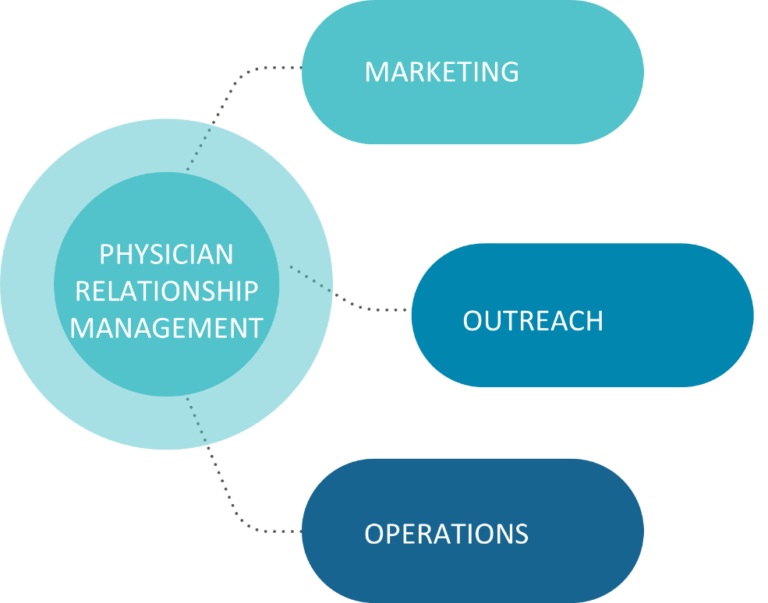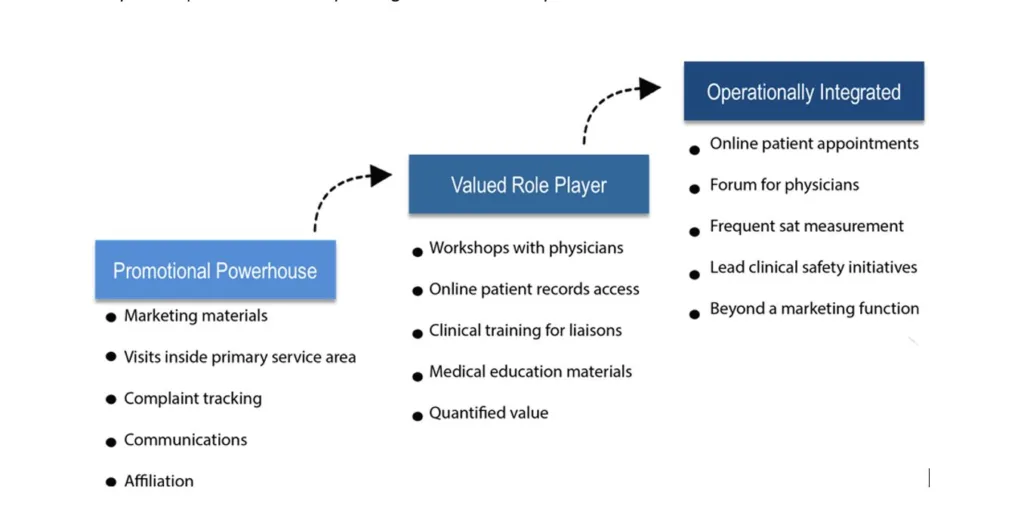
Effective
Physician
Relationship Management
The Holistic View
It’s no surprise that today’s hospitals and healthcare systems are increasingly focused on building and sustaining relationships with referring physicians. All are striving to deploy effective physician relationship management programs. The reason is simple: Referring physicians continue to account for a substantial percentage of patient volume and serve as a channel for patients to seek health services. Yet, they are often under-appreciated and neglected in the continuum of patient care. Despite good intentions, lack of a holistic strategy and processes that support it does not facilitate the building of meaningful relationships with referring physicians. We discuss the importance of a Physician Relationship Management Strategy in facilitating strong referring physician relationships. We also outline three key components to a holistic and effective Physician Relationship Management Strategy. The objective of a Physician Relationship Management Strategy is to create opportunities for collegial and mutually beneficial interactions between a hospital’s internal staff and providers and external referring physicians. It outlines a plan to cultivate relationships with referring physicians that will promote loyalty and advocacy, supporting clinical and growth goals. Despite the importance of a Physician Relationship Management Strategy, it can be difficult to know where to begin and what to include – leading to an underdeveloped or nonexistent strategy.
A Change of Mindset
In the consumer world of marketing, it is widely understood that sales, access/contact centers, and marketing must overlap and work together. This is also true in the healthcare B2B environment – that is, in building relationships with referring physicians. Physician relationship management is an overarching umbrella that should encompass a variety of activities and integrate stakeholders that are impactful to referring physicians.

Getting Started
It’s extremely important not only to define each element, but also identify its purpose in meeting your goals:
Physician Marketing generates awareness, creates demand and re-markets services. Activities are content and distribution focused. Physician marketing promotes awareness and access to meaningful information, both that builds clinical expertise and makes it easy to refer through knowing what services and physicians are available. Objectives related to physician marketing should be focused on awareness and information gathering activities. It’s fundamentally the top of the sales pipeline – making it easier for liaisons to distribute the message and allowing high potential physicians to engage the organization during the first few steps of the referral process. Key touchpoints typically include websites, email marketing, trade shows, and printed materials.
Physician Outreach refers to the direct relationship building activities done between individuals. A common misperception is that outreach activities are only done by liaisons – but effective outreach is cross-functional, including medical staff. In fact, while liaisons may be the most frequent source of contact, most referring physicians want and expect medical staff to periodically reach out to them to build rapport and increase confidence in making a referral. Outreach build personal interactions and includes those with whom physicians (or their staff) interact with at each stage of the experience – including scheduling, care coordination during treatment, and transition of care. Touchpoints range from phone calls, emails, or the portal to CME and other on-site meetings, such as visits to the physician’s office.
Operations refers to the coordination of care, communications and behaviors during the continuum of the experience, from access to transition back to the care of the referring physician. Operational issues such as difficulty securing an appointment with the right provider, or not receiving an update after a patient’s referral a frequent source of frustration for referring physicians. These are commonly cited as reasons for splitting referrals (only to those physicians or service lines that do it well) or switching referral patterns elsewhere. Successful organizations orchestrate these series of activities across multiple internal teams to ensure an exception experience for the referring physician. This is quite challenging given the number of touchpoints and “silos.”
The Continuum of Physician Relationship Management
Our experience is that hospitals and health systems are often successful in one of these areas but haven’t yet evolved into a more comprehensive approach to manage the physician experience holistically. Based on our work with organizations around the country and physician benchmarking studies, we have outlined below some key activities for building strong relationships with referring physicians. This can also serve to change internal mindset of what physician relationship management truly encompasses. Where do your organization currently sit on this continuum?

Taking Action
In sum, a successful, multifaceted Physician Relationship Management plan is worth the effort. Positioning as a referral center of a choice (relevant to market and brand promise) advances the hospital’s recognition as a leader in creating a collaborative physician community aimed at expanding world-class healthcare. Rewards of increased physician awareness, a loyal physician referral database, and a continuous flow of patient referrals promote growth. If getting started seems overwhelming, here are some actions that will advance physician relationship management efforts:
- Define your objectives – what are you trying to accomplish, and how will you measure success?
- Ensure that you have a solid understanding of the needs, interests, expectations and priorities of your medical staff (employed and affiliated) and of your referring physicians. Depending on information available, this might require additional research. Consider Referring Physician Experience Mapping for an in-depth understanding of needs. Read an Experience Mapping case study here.
- Restructure conversations with internal stakeholders to think about the “business” rather than tactics.
- Include yourself or lead clinical operations conversations and decision making.
- Reinforce the fact that referring physician relationships influence the majority of your clinical volumes
- Align physician relations efforts in a manner that contributes to organizational priorities and supports external physician and patient requirements.
Let’s Talk
We will help you overcome strategic challenges to realize the business value you seek.